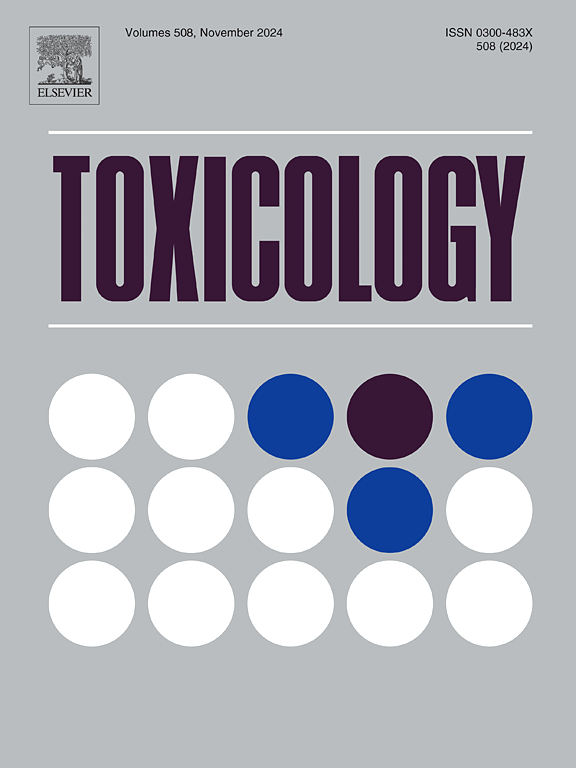Copper oxide nanoparticles induce pulmonary inflammation via triggering cellular cuproptosis
IF 4.8
3区 医学
Q1 PHARMACOLOGY & PHARMACY
引用次数: 0
Abstract
Copper oxide nanoparticles (CuO NPs) are increasingly used in various industrial fields, and the toxicity of CuO NPs raises concerns. However, the CuO NPs-induced pulmonary inflammation and the underlying mechanism have not been fully illustrated. Cellular cuproptosis provides a new perspective to elucidate the toxicity of CuO NPs. Here, we exposed C57BL/6 mice and murine alveolar macrophage cells (MH-S) to CuO NPs, respectively. A suspension of 2 mg/mL CuO NPs was directly once administered by intratracheal instillation, and mice were sacrificed on day 7. The histopathology results showed that CuO NPs induced pulmonary inflammation in C57BL/6 mice. CuO NPs increased Cu2 + levels by 203.0 % in mouse lung tissues. Also, CuO NPs increased the cuproptosis-related indicators of ferredoxin (FDX1), dihydrolipoamide succinyltransferase (DLST), dihydrolipoamide acetyltransferase (DLAT) and Cu transporter 1 (CTR1) in both mouse lung tissues and MH-S cells. Transcript sequencing and non-targeted metabolomics indicated that CuO NPs induced cellular cuproptosis and inflammatory responses both in vivo and in vitro. Interleukin-17a (IL-17A) was remarkably increased in the process of CuO NPs-induced cellular cuproptosis. Additionally, interference of FDX1 reduced cellular cuproptosis and decreased the release of IL-17A. In summary, CuO NPs increased the accumulation of intracellular Cu2+ and the expressions of cuproptosis-related proteins, induced FDX1-mediated cuproptosis, and led to pulmonary inflammation in mice. This study highlights the respiratory toxicity of CuO NPs and reveals a unique cuproptosis-driven mechanism underlying the CuO NPs-induced pulmonary inflammation.
氧化铜纳米颗粒通过触发细胞铜增生诱导肺部炎症
氧化铜纳米颗粒(CuO NPs)越来越多地应用于各个工业领域,其毒性引起了人们的关注。然而,CuO nps诱导的肺部炎症及其潜在机制尚未完全阐明。细胞铜增生为阐明CuO NPs的毒性提供了新的视角。本研究将C57BL/6小鼠和小鼠肺泡巨噬细胞(MH-S)分别暴露于CuO NPs中。2 mg/mL CuO NPs混悬液经气管内滴注一次,第7天处死小鼠。组织病理学结果显示,CuO NPs可诱导C57BL/6小鼠肺部炎症。CuO NPs使小鼠肺组织中Cu2 +水平升高203.0 %。CuO NPs增加了小鼠肺组织和MH-S细胞中铁氧还蛋白(FDX1)、二氢脂酰胺琥珀基转移酶(DLST)、二氢脂酰胺乙酰基转移酶(DLAT)和铜转运蛋白1 (CTR1)的铜增殖相关指标。转录本测序和非靶向代谢组学表明,CuO NPs在体内和体外均可诱导细胞铜化和炎症反应。白细胞介素-17a (IL-17A)在CuO nps诱导的细胞铜增生过程中显著升高。此外,FDX1的干扰减少了细胞铜增生,减少了IL-17A的释放。综上所述,CuO NPs增加了细胞内Cu2+的积累和铜裂相关蛋白的表达,诱导了fdx1介导的铜裂,并导致小鼠肺部炎症。本研究强调了CuO NPs的呼吸毒性,并揭示了CuO NPs诱导肺部炎症的独特cuproosis驱动机制。
本文章由计算机程序翻译,如有差异,请以英文原文为准。
求助全文
约1分钟内获得全文
求助全文
来源期刊

Toxicology
医学-毒理学
CiteScore
7.80
自引率
4.40%
发文量
222
审稿时长
23 days
期刊介绍:
Toxicology is an international, peer-reviewed journal that publishes only the highest quality original scientific research and critical reviews describing hypothesis-based investigations into mechanisms of toxicity associated with exposures to xenobiotic chemicals, particularly as it relates to human health. In this respect "mechanisms" is defined on both the macro (e.g. physiological, biological, kinetic, species, sex, etc.) and molecular (genomic, transcriptomic, metabolic, etc.) scale. Emphasis is placed on findings that identify novel hazards and that can be extrapolated to exposures and mechanisms that are relevant to estimating human risk. Toxicology also publishes brief communications, personal commentaries and opinion articles, as well as concise expert reviews on contemporary topics. All research and review articles published in Toxicology are subject to rigorous peer review. Authors are asked to contact the Editor-in-Chief prior to submitting review articles or commentaries for consideration for publication in Toxicology.
 求助内容:
求助内容: 应助结果提醒方式:
应助结果提醒方式:


